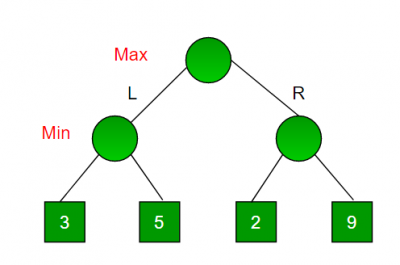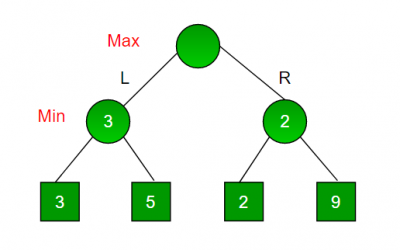Table of Contents
Chess - Programming - Minimax Algorithm
Minimax is a kind of backtracking algorithm that is used in decision making and game theory to find the optimal move for a player, assuming that your opponent also plays optimally.
- In Minimax the two players are called maximizer and minimizer.
- The maximizer tries to get the highest score possible while the minimizer tries to do the opposite and get the lowest score possible.
Every board state has a value associated with it.
- In a given state if the maximizer has upper hand then, the score of the board will tend to be some positive value.
- If the minimizer has the upper hand in that board state then it will tend to be some negative value.
- The values of the board are calculated by some heuristics which are unique for every type of game.
Since this is a backtracking based algorithm, it tries all possible moves, then backtracks and makes a decision.
A program to illustrate the Minimax Algorithm
A Tic-Tac-Toe example program to illustrate the Minimax Algorithm
Pseudocode
function minimax(board, depth, isMaximizingPlayer): if current board state is a terminal state : return value of the board if isMaximizingPlayer : bestVal = -INFINITY for each move in board : value = minimax(board, depth+1, false) bestVal = max( bestVal, value) return bestVal else : bestVal = +INFINITY for each move in board : value = minimax(board, depth+1, true) bestVal = min( bestVal, value) return bestVal
Example
Consider a game which has 4 final states and paths to reach final state are from root to 4 leaves of a perfect binary tree as shown below.
- Assume you are the maximizing player and you get the first chance to move, i.e., you are at the root and your opponent at next level.
- Which move you would make as a maximizing player considering that your opponent also plays optimally?
Since this is a backtracking based algorithm, it tries all possible moves, then backtracks and makes a decision.
- Maximizer goes LEFT:
- It is now the minimizers turn.
- The minimizer now has a choice between 3 and 5.
- Being the minimizer it will definitely choose the least among both, that is 3.
- Maximizer goes RIGHT:
- It is now the minimizers turn.
- The minimizer now has a choice between 2 and 9.
- He will choose 2 as it is the least among the two values.
Being the maximizer you would choose the larger value that is 3.
- Hence the optimal move for the maximizer is to go LEFT and the optimal value is 3.
Now the game tree looks like below:
The above tree shows two possible scores when maximizer makes left and right moves.
NOTE: Even though there is a value of 9 on the right subtree, the minimizer will never pick that.
- We must always assume that our opponent plays optimally.

